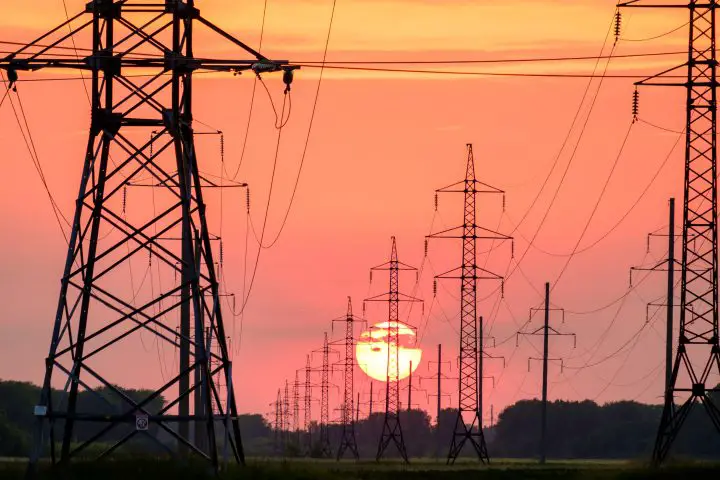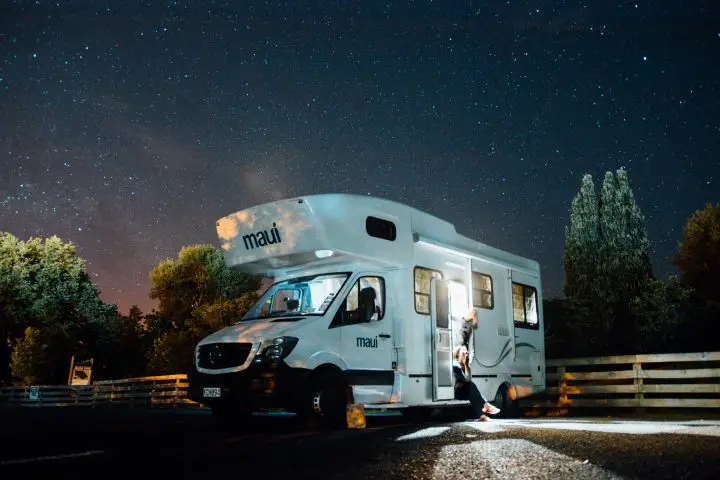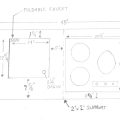Hey! This site is reader-supported and we earn commissions if you purchase products from retailers after clicking on a link from our site.
Electrical wiring in your RV can be a daunting task. There’s a ton of jargon to wade through. But if you’re willing to do a little research and learn a few terms, most projects are well within the abilities of a do-it-yourself-er. Whether you’re just replacing a supply panel or building your own teardrop trailer and wiring the living space, here’s some valuable advice on hooking up a 50-amp service.
Hopefully, we can answer some of your questions in this article. But keep in mind that properly wiring an RV is a big job fraught with all kinds of little issues. If you are inexperienced with electrical engineering –and RV wiring specifically–it’s best to seek the advice and skill of a paid professional electrician.

Electrical Energy 101
Before diving into RV electrical connections, it’s probably a good idea to discuss some basics of electricity. Many different units are used, and electrical systems are not cross-compatible.
Electricity is often explained as being analogous to water flowing through a pipe. This is a good tool to visualize the situation since electricity is more or less invisible.
Volts (Voltage)
Voltage is a measurement of the force of electricity. For example, a car battery has 12 volts, a standard American wall outlet has 120 volts, and a lightning bolt has something in the order of 300 million volts.
You can move voltage through any size of wire; voltage does not determine wire size.
Amps (Amperage or Electrical Current)
Amperage is the measurement of how much current there is. So in the water pipe analogy, how many amps are flowing is like the flow rate. One gallon per minute is flowing through, or 50 liters per hour.
As you might imagine, a bigger pipe lets more water flow through. Similarly, larger wires allow more amps to flow through.
Amperage is the determining factor in picking what size wire to use. The more electrical current you want to move through your wire, the bigger the wire will need to be. This is true regardless of the voltage in question.
Watts (Wattage)
Watts is a total measurement of how much power an appliance uses. However, if you think about the measurements described above, neither one provides the whole story on its own.
A LED lightbulb uses around 4 watts; a laptop charger is usually around 80 watts. Most microwaves and toasters are 1,200 watts or so.
Check out our article on the best travel trailer batteries for a great guide on understanding wattage and how to calculate your rig’s power consumption.
Power Equation
It’s easy to do the math if you have a missing piece. The power formula is simple:
Volts x Amps = Watts
This is a handy formula to know and use. In analyzing, planning, and improving your electrical system, you’ll often see a mashup of different units used to describe a sub-panel or an individual appliance. By doing this quick formula, you can easily master any conversions quickly.
Ohms (Resistance)
Ohms is a measurement of resistance. Resistance can be thought of as friction–it resists the current flow. The more conductive material is, the less resistance it has. So copper wire has little resistance, but even a little can accumulate. The longer the wire, the more resistance it will impose.
Resistance causes a significant voltage drop from one end of the wire to another. So, to overcome that resistance, you must increase the thickness of the wire you use on very long runs. So when you read that a six gauge wire can carry 50 amps, you must also consider how long the wire is. If you need a long wire, you’ll also need a bigger wire.
Resistance can also be caused by bad electrical connections and faulty wiring hookup. Or it can be caused by a broken or damaged wire. When a connection or wire has too much resistance, it will heat up. This is exactly how electrical fires get started.

Types of RV Power
AC or DC Power
Your RV electrical system probably has two separate power circuits, which can make things doubly confusing.
The DC (Direct Current) system is the one that runs off of the batteries. This is here to make sure everything works when you aren’t plugged in or are boondocking or off the grid. But, of course, it also means that things work while you’re on the road or between stops.
The AC (Alternating Current) system is the one that gets its power through the shore power cord when you are plugged in. AC is the type of electricity that traditional brick-and-mortar homes run off of. Big appliances, like your air conditioner, run off of AC power.
The two types of electricity are not compatible. You can’t plug an AC appliance into DC power, and you can’t plug a DC one into AC power. But, you can make DC power from AC with one of the best power converter panels. Or, you can make AC from DC if you install an inverter in your rig.
Each system is also voltage specific. For example, most motorhomes and campers in the US are either 12 or 24-volt DC systems and 110-volt AC systems.
30 Amps vs. 50 Amps
When you hear about 30 or 50-amp hookups, it is a reference to the AC power that comes from your shore power cord.
Traditionally, most RVs were wired with one 30-amp shore power plug. But today, as more rigs come with two rooftop air conditioners, electric water heaters, and other power-hungry electrical equipment, 50-amp service is not uncommon.
Amps are a measurement of how much electricity is flowing through the line. Since all of your RV’s power comes through one cord, that cord must be big enough to power everything.
And, of course, it isn’t just the cord. The RV outlet you plug into at your house or RV park must also connect to a wire that is the right size. And the outlet and wiring inside your motorhome need to be sized correctly. In other words, it’s not just the cord but the entire system. Fuses, circuit breakers, sockets, and wires must all be sized to deliver the right amount of power safely.
You can think of electricity as water flowing through the plumbing in your home. So a 50-amp system can supply more than a 30-amp system can. How? By having bigger pipes! A 50-amp circuit will have significantly thicker wires, which can carry more electricity–just like bigger pipes can carry more water.
Which one does your RV have, 30 or 50-amp service? Besides just looking at the side of the cord, the RV plug will look different. A 30-amp socket has two wires (hot and neutral) plus a ground wire (green wire). A 50-amp socket has four prongs–two hot wires, a neutral, and a ground wire.
It’s also a fair bet that if you have 50-amp service, you’ll have two 30-amp sub-panels or breaker panels on the inside.
110 vs. 220 Volts
Amps are only half of the electrical equation. You also need to consider the voltage and how it plays a part in the system.
A 30-amp shore power plug is going to provide 30-amps at 110 volts. On an RV, a 50-amp cord supplies two lines of 110-volt power for a total of 220 volts. So, a 50-amp cord supplies not only (almost) double the amperes but double the voltage as well.
Since no appliances inside the RV use 220-volt power, the two inputs are kept separate and feed separate panels. As a result, 110-volt AC power is still used and still the standard for your electronics.
Types and Sizes of Wire
Now that we’ve covered a little about power systems you might find on an RV, let’s look at some specific things about the wire itself.
Solid vs. Stranded Wire
Most home wiring is done with solid copper wire. This is commonly sold at Home Depot and is widely available. But, for various reasons, it’s not the best thing to use in RVs.
One of the biggest disadvantages of solid wire is that it is brittle–it doesn’t bend well and doesn’t withstand vibrations well. Both of these are big problems in an RV. When solid wire breaks, it will cause the circuit to fail. A short circuit could result, as could a fire.
A better solution is stranded wire. This type of wire is made up of tiny individual strands of wire. The result is a bendable wire, so you can easily feed it through tight spaces and around corners. Plus, stranded wire withstands the vibrations much better.
Wire Sizes – Gauges (AWG) Explained
Wires are measured by their gauge. The American Wire Gauge (AWG) number will tell you how large a wire is so that you can get exactly the right size.
One confusing thing, however, is that gauges might seem backward. A smaller wire gauge, like 1 AWG, is a big wire with a larger diameter. Small wires have a big number, like 16 AWG–which is commonly used for speaker wires.
Gauges also go below zero, so the largest wire is not a 1 AWG. Battery cables often get bigger and are measured down from 0 AWG (“aught”). The biggest battery cable commonly available is 4/0 AWG (“four aught,” sometimes written 0000 AWG).
| AWG | Diameter (mm) | Area (sq-mm) | Ampacity at 60ºC |
|---|---|---|---|
| 0000 (4/0) | 11.684 | 107 | 195 |
| 00 (2/0) | 9.266 | 67.4 | 145 |
| 0 (1/0) | 8.251 | 53.5 | 125 |
| 2 | 6.544 | 33.6 | 95 |
| 4 | 5.189 | 21.2 | 70 |
| 6 | 4.115 | 13.3 | 55 |
| 8 | 3.264 | 8.37 | 40 |
| 10 | 2.588 | 5.26 | 30 |
| 12 | 2.053 | 3.31 | 20 |
| 14 | 1.628 | 2.08 | 15 |
| 16 | 1.291 | 1.31 | 10 |
| 18 | 1.024 | 0.823 | 10 |
| 20 | 0.812 | 0.518 | 5 |
Aluminum vs. Copper Wires
Aluminum wires and copper-plated aluminum wires were widely used in wiring applications in previous decades. However, most of the wire you buy now will be pure copper wire, which has better conductivity and less resistance.
The conductivity of the material matters because it will affect which size of wire you need. For every job, you’ll need to calculate how much wire you need and what size (which AWG). For example, if you have a mix of aluminum and copper, that will affect the gauge you need to purchase.
Getting the Right Wire for the Job
Purpose of the Wire
Every wire that makes up your electrical system requires different calculations. This is why you can’t easily answer what size wire for 50 amp RV service. Every circuit is different. Are you supply power to the hookup box? Or are you replacing the cable? Are you wiring a new panel inside the RV?
Total Load (Amperage)
The biggest factor that differentiates what wire gauge you should choose is the total load that circuit might ever draw.
This isn’t easy when replacing the breaker panel or shore power cord because you must consider the cumulative load of all the items running in your RV. In addition, you have to plan for the worst-case scenario–what if everything were running at once. The math will get progressively more difficult if you’ve got multiple air conditioners, an electric water heater, and many kitchen appliances. Also, don’t forget big power consumers like the battery charger and converter.
Drawing too much power through a too-small wire can cause many problems. First and foremost, it is a serious fire hazard. As more current flows through the wire, it will heat up. Eventually, it can melt the wire coatings and cause short circuits and electrical arcing.
Length of Run
A more insidious and often overlooked factor in your planning is the wire run length. The longer a wire is, the more resistance it causes. As resistance goes up, the voltage goes down. That means the voltage will drop from one end of the wire to the other.
For most applications, you never want the voltage to drop more than three percent. Any more than this, and you might have trouble with appliances, especially compressors in your air conditioning or refrigeration. This might not be noticeable when the appliance is off, but when it starts up and draws a lot of power, the voltage drop can spike, and the appliance may cut off.
The longer the wire, the greater the amount of voltage drop. If your wire run is too long, then the only way to minimize voltage drop is to increase the size of the wire to a bigger gauge. For 50 amp service, which has a minimum size of 6 AWG, you might have to step up to 4 AWG.
National Electrical Code (NEC) Rules
The National Electrical Code also has an important rule to consider: the 80 Percent Rule. Basically, it states that when designing a circuit, you should never load it more than 80 percent of that circuit’s wiring rating.
When in doubt or right on the line, always default to getting bigger wire. There’s never a downside to getting bigger wire besides its extra expense and weight.
Putting It All Together – Getting the Right Wire Gauge
Start your search for the right wire size by looking at the amperage rating for each size on a wire gauge table. This will give you an idea of what the wire can take, but only for short runs.
Then consider the length of the wire run. This might not be a straight line, especially in an RV where the wire may snake through wire runs and cabinets. Be sure to measure the exact run length and consider the overall resistance and voltage drop. A good rule of thumb is that the voltage will drop 20 percent for every 100 feet of wire.
The easiest way to figure out which is the right size wire is to use an online calculator. Math formulas and tables are available to help you calculate which AWG wire will provide how many amps with a length of a cable run. But an online wire calculator makes it all very simple.
FAQs (Frequently Asked Questions)
Can 8-gauge wire handle 50 amps?
No. An 8 AWG copper wire is rated to carry only 40 amps.
What size wire do I need to run 50 amps 100 feet?
The size wire will depend on the allowable voltage drop. For example, the minimum wire size to run a 50 amp service is 6 AWG. But to keep the below the normal allowable 3% voltage drop threshold, it would be better to go up to 4 AWG copper wires.
Will 10 gauge wire carry 50 amps?
No. A 10 AWG copper wire is rated to carry only 30 amps.






